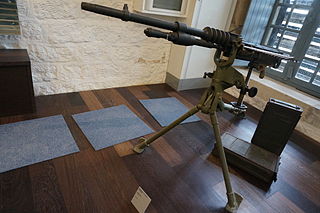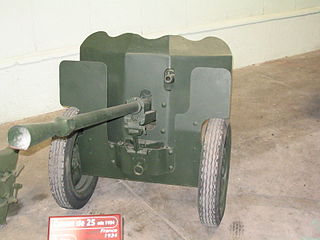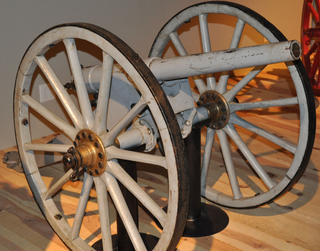| Industry | Manufacturing |
|---|---|
| Founded | Paris, France (1875) |
| Founder | Benjamin B. Hotchkiss |
| Headquarters | , |
| Products |
|


The Hotchkiss Ordnance Company was an English armaments manufacturer founded by American ordnance engineer Benjamin B. Hotchkiss.
| Industry | Manufacturing |
|---|---|
| Founded | Paris, France (1875) |
| Founder | Benjamin B. Hotchkiss |
| Headquarters | , |
| Products |
|


The Hotchkiss Ordnance Company was an English armaments manufacturer founded by American ordnance engineer Benjamin B. Hotchkiss.
In the 1850s, Hotchkiss was employed as a gunsmith in Hartford, working on Colt revolvers and Winchester rifles. He went to France in 1867 and organized Hotchkiss & Co. in 1875, setting up offices in Paris and manufacturing facilities in Saint-Denis. This company enjoyed success and the confidence of French authorities, receiving large governmental orders and was allowed to export arms to other countries. In 1884, Hotchkiss and William Armstrong & Co. of England agreed to manufacture Hotchkiss guns at the Elswick works.
Hotchkiss died in 1885, and in 1887 the affairs of both companies were placed under the French corporation and renamed respectively, the Société Anonyme des Anciens Etablissements Hotchkiss et Cie of France and the Hotchkiss Ordnance Company, Ltd. in England. [1]
Hotchkiss may refer to:

Société Anonyme des Anciens Etablissements Hotchkiss et Compagnie was a French arms and, in the 20th century, automobile manufacturer first established by United States gunsmith Benjamin B. Hotchkiss (1826–1885). He moved to France and set up a factory, first at Viviez near Rodez in 1867, manufacturing arms used by the French in the Franco-Prussian War of 1870, then moving at Saint-Denis near Paris in 1875. It was merged into and succeeded by Thomson-CSF, now Thales Group.
A rifled breech loader (RBL) is an artillery piece which, unlike the smoothbore cannon and rifled muzzle loader (RML) which preceded it, has rifling in the barrel and is loaded from the breech at the rear of the gun.
The M1917 Browning machine gun is a heavy machine gun used by the United States armed forces in World War I, World War II, the Korean War, and the Vietnam War; it has also been used by other nations. It was a crew-served, belt-fed, water-cooled machine gun that served alongside the much lighter air-cooled Browning M1919. It was used at the battalion level, and often mounted on vehicles. There were two main iterations: the M1917, which was used in World War I and the M1917A1, which was used thereafter. The M1917, which was used on some aircraft as well as in a ground role, had a cyclic rate of 450 rounds per minute. The M1917A1 had a cyclic rate of 450 to 600 rounds per minute.

Benjamin Berkeley Hotchkiss was one of the leading American ordnance engineers of his day.

The Type 3 heavy machine gun, also known as the Taishō 14 machine gun, was a Japanese air-cooled heavy machine gun. The Type 3 heavy machine gun was in a long-line of Japanese Hotchkiss machine gun variants that the Imperial Japanese Army would utilize from 1901 to 1945.

The Mle 1914 Hotchkiss machine gun chambered for the 8mm Lebel cartridge became the standard machine gun of the French Army during the latter half of World War I. It was manufactured by the French arms company Hotchkiss et Cie, which had been established in the 1860s by American industrialist Benjamin B. Hotchkiss. The gas-actuated Hotchkiss system was first formulated in 1893 by Odkolek von Ujezda and improved into its final form by Hotchkiss armament engineers, American Laurence Benét and his French assistant Henri Mercié.
The Hotchkiss M1909 machine gun was a light machine gun of the early 20th century, developed and built by Hotchkiss et Cie. It was also known as the Hotchkiss Mark I, Hotchkiss Portative and M1909 Benét–Mercié.

The Hotchkiss machine gun was any of a line of products developed and sold by Hotchkiss et Cie,, established by United States gunsmith Benjamin B. Hotchkiss. Hotchkiss moved to France and set up a factory, first at Viviez near Rodez in 1867, then at Saint-Denis near Paris in 1875 manufacturing arms used by the French in the Franco-Prussian War.

Charles Tillinghast James was a consulting manufacturing engineer, early proponent of steam mills, and United States Democratic Senator from the state of Rhode Island from 1851 to 1857.

The 25 mm Hotchkiss anti-tank gun was a French anti-tank gun from the 1930s, built by the Hotchkiss arsenal, that saw service in the Spanish Civil War, the Second World War and the Indochina War.

The Hotchkiss 25 mm anti-aircraft gun was an anti-aircraft autocannon designed by the French firm of Hotchkiss. It served in World War II with French, Japanese and other nations' forces. Other than the designer company and the calibre, this weapon is not related to the semi-automatic 25 mm Hotchkiss anti-tank gun; in particular, the cartridge used is different.

The Hotchkiss 13.2 mm machine gun, also known as the Hotchkiss M1929 machine gun, was a heavy machine gun, primarily intended for anti-aircraft use, designed and manufactured by French arms manufacturer Hotchkiss et Cie from the late 1920s until World War II, which saw service with various nations' forces, including Italy and Japan where the gun was built under license.

The Ordnance QF Hotchkiss 6 pounder gun Mk I and Mk II or QF 6 pounder 8 cwt were a family of long-lived light 57 mm naval guns introduced in 1885 to defend against new, small and fast vessels such as torpedo boats and later submarines. There were many variants produced, often under license which ranged in length from 40 to 58 calibers, but 40 caliber was the most common version.

The QF 3-pounder Hotchkiss or in French use Canon Hotchkiss à tir rapide de 47 mm were a family of long-lived light 47 mm naval guns introduced in 1886 to defend against new, small and fast vessels such as torpedo boats and later submarines. There were many variants produced, often under license which ranged in length from 32 to 50 calibers but 40 caliber was the most common version. They were widely used by the navies of a number of nations and often used by both sides in a conflict. They were also used ashore as coastal defense guns and later as an anti-aircraft gun, whether on improvised or specialized HA/LA mounts.
A quick-firing or rapid-firing gun is an artillery piece, typically a gun or howitzer, which has several characteristics which taken together mean the weapon can fire at a fast rate. Quick-firing was introduced worldwide in the 1880s and 1890s and had a marked impact on war both on land and at sea.

The French St. Étienne Mle 1907 was a gas operated air-cooled machine gun in 8mm Lebel which was widely used in the early years of the First World War. The "St.Etienne Mle 1907" was not derived from the Hotchkiss machine gun. Instead it was an entirely different gas operated, blow-forward design borrowed from the semi-automatic Bang rifle of 1903. This Bang system was first transposed in 1905 to the French Puteaux APX Machine Gun which soon proved to be unsatisfactory. Then, two years later, the Mle 1907 "St-Étienne" machine gun followed as an improved redesign of the "Puteaux" machine gun. However the Mle 1907 "St-Étienne" was only a partial redesign: the original blow-forward gas piston, rack-and-pinion system, and bolt mechanism of the Mle 1905 "Puteaux" machine gun had all been kept only slightly modified inside the newer weapon. Eventually a total of over 39,700 "St-Étienne" Mle 1907 machine guns were manufactured between 1908 and late 1917. They were widely used by French infantry during the early part of World War I until their replacement by the more reliable Hotchkiss M1914 machine gun.

The M1875 mountain gun is a mountain gun that was used by the United States Army during the last quarter of the nineteenth century.

The Remington–Keene is an early bolt-action rifle with a tubular magazine.